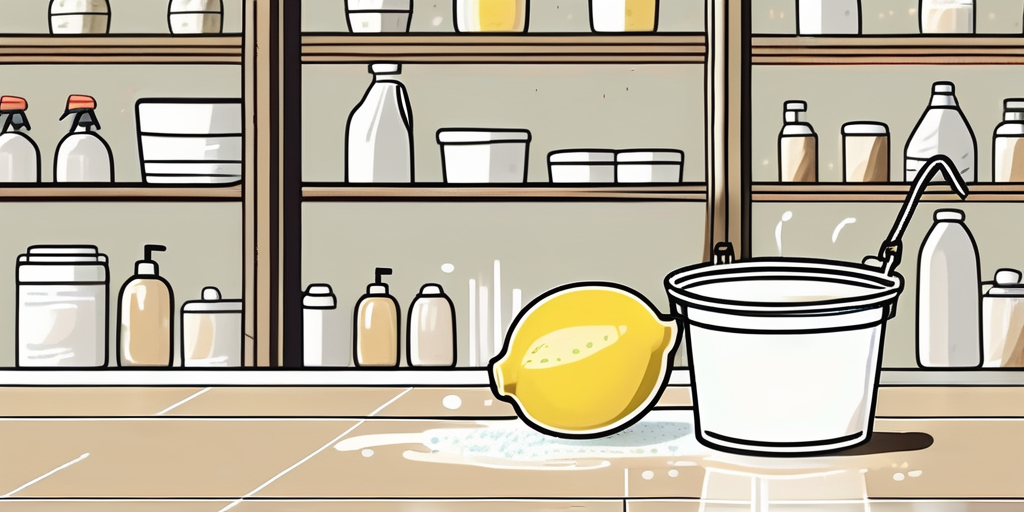Travertine, a type of limestone, is a popular choice for flooring in homes and offices due to its durability and unique aesthetic appeal. However, maintaining its natural beauty requires regular cleaning and care. This guide will walk you through the process of cleaning your travertine floors naturally and professionally.
The Importance of Regular Cleaning
Travertine is a porous material, which means it can easily absorb liquids and grime if not properly sealed. Regular cleaning not only keeps your floors looking their best, but also extends their lifespan and maintains their value.
Moreover, using natural cleaning methods is beneficial for both your health and the environment. Many commercial cleaning products contain harsh chemicals that can cause health problems and contribute to pollution. By cleaning your travertine floors naturally, you can avoid these issues while still achieving a professional-level clean.
Understanding Travertine
Before diving into the cleaning process, it’s important to understand the nature of travertine. As a form of limestone, travertine is softer and more susceptible to damage than other types of stone. It’s also highly reactive to acidic substances, which can etch or dull its surface.
Therefore, when cleaning travertine, it’s crucial to avoid acidic cleaners like vinegar or lemon juice. Instead, opt for pH-neutral cleaners that won’t harm the stone. Additionally, always test any new cleaning product on a small, inconspicuous area of your floor before applying it to the entire surface.
Materials Needed
Before you start, gather all the necessary materials. Here’s what you’ll need:
- A soft, dry mop or broom
- A bucket
- Warm water
- pH-neutral stone cleaner
- A soft, non-abrasive cloth or sponge
- A dry towel
Step-by-Step Guide to Cleaning Travertine Floors
Step 1: Dry Mop or Sweep the Floor
Start by removing any loose dirt or debris from your floor using a soft, dry mop or broom. This step is important because any grit left on the floor can scratch the travertine when you mop it.
Be sure to get into all the corners and along the baseboards, where dirt tends to accumulate. If your floor has a textured surface, you may need to use a brush to dislodge any dirt trapped in the crevices.
Step 2: Prepare the Cleaning Solution
Next, fill your bucket with warm water. The water should be warm, but not hot. Then, add a small amount of pH-neutral stone cleaner according to the manufacturer’s instructions. Stir the solution until the cleaner is fully dissolved.
Remember, it’s better to start with a weaker solution and add more cleaner if necessary. Using too much cleaner can leave a residue on your floor, which can attract more dirt.
Step 3: Mop the Floor
Now you’re ready to mop the floor. Soak your mop or cloth in the cleaning solution, then wring it out so it’s damp, but not dripping wet. Mop the floor in small sections, rinsing and wringing out your mop frequently to ensure you’re not just spreading the dirt around.
As you mop, pay special attention to any stained or dirty areas. If necessary, you can scrub these areas gently with a soft, non-abrasive cloth or sponge. However, avoid scrubbing too hard, as this can scratch the travertine.
Step 4: Dry the Floor
Once you’ve mopped the entire floor, it’s important to dry it thoroughly. Leaving water on your travertine floor can cause water spots or damage the stone. Use a dry towel to wipe up any excess water, then let the floor air dry completely.
If your floor is still dirty after mopping, you may need to repeat the process. However, if you’re cleaning your floor regularly, a single pass should be sufficient.
Additional Tips for Maintaining Travertine Floors
In addition to regular cleaning, there are several other steps you can take to keep your travertine floors looking their best:
- Seal your floors: Travertine is porous, so it’s important to seal your floors to protect them from stains and damage. You should reseal your floors every one to two years, or more often if they’re in a high-traffic area.
- Avoid acidic substances: As mentioned earlier, travertine is reactive to acidic substances. Avoid using acidic cleaners, and clean up any spills (like wine or fruit juice) immediately to prevent etching.
- Use mats or rugs: Place mats or rugs in high-traffic areas to protect your floors from wear and tear. Just be sure to clean under the mats regularly to prevent dirt buildup.
- Use furniture pads: If you have furniture on your travertine floors, use felt pads under the legs to prevent scratches.
With regular cleaning and proper care, your travertine floors can remain beautiful and durable for many years. Remember, the key to maintaining any natural stone floor is to clean it regularly and treat it gently. By following these tips, you can clean your travertine floors naturally and professionally, preserving their beauty for future generations to enjoy.
Join the HowToClean.pro Cleaning Community
Ready to elevate your cleaning game beyond just travertine floors? Become a part of the HowToClean.pro family! Our free email list is your treasure trove of cleaning wisdom, offering a wealth of tips, techniques, and advice for tackling spills and stains on all your valued possessions. From everyday mishaps to the most daunting of cleaning challenges, we’ve got you covered. Subscribe now and gain access to exclusive article roundups, special offers, and professional insights. With HowToClean.pro in your corner, you’ll never be at a loss for how to clean anything—like a pro!

